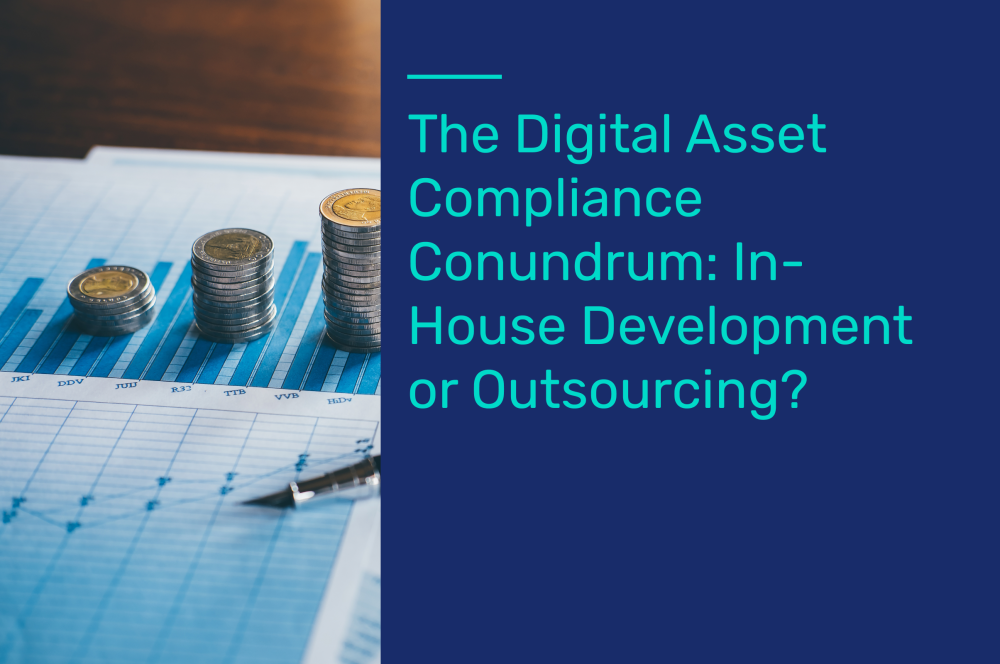The Digital Asset Compliance Conundrum: In-House Development or Outsourcing?
A CTO’s perspective on the trade-offs and high stakes for “build versus buy” to meet evolving regulatory requirements

Published on:

As the world of digital assets continues to evolve, so too does the complexity of regulatory compliance for enterprises. For companies engaging with crypto, one of the most significant decisions that leaders face is whether to meet evolving business needs by building in-house compliance solutions or partnering with expert external vendors.
Digital asset enterprises, fintech firms, and financial institutions face an array of compliance complexities for accurate accounting of high-volume transactions, meeting Bank Secrecy Act requirements, conducting tax information reporting, and more. Completing each compliance component in a quickly-changing environment can be daunting, so a strategic and comprehensive approach is necessary.
Enterprises and their CTOs should carefully evaluate the challenges, benefits, and risks associated with the “buy versus build” question for tax and accounting compliance. John Dalby, Chief Financial Officer of NYDIG, one of the world’s leading digital asset enterprises, once explained their rationale for approaching this question:
“We like to buy as opposed to build, we have to build in certain spaces where we are unique. But, if you could find somebody who does something well for a living, I would rather work with them in a strategic partnership way.”
A Technology Leader’s Perspective on Buy vs. Build
When approaching this important question I wanted to offer my personal perspective, informed by years of enterprise technology leadership prior to my current role at TaxBit.
During my tenure as an engineering leader at Nintendo, for example, I was tasked with solving the buy vs. build question with respect to a payments system. Ultimately, we decided to not build a payments system in-house as doing so would distract from our core business (i.e., delighting users by building experiences cemented in brand and technology offerings). The wisdom of this decision quickly became evident as we grasped the complexities of regional and local tax payment issues – a challenge that would have been exorbitantly difficult to solve from scratch.
It can seem easy at first for business leaders to estimate the trade-offs between short- and long-term investments; however, this trade-off is often much more difficult in practice. In-house solutions can take immense time, focus, and operational costs to complete while external solutions may be faster to deploy with fewer internal resources at a higher (perceived) initial cost.
Now at TaxBit, we respect this eternal enterprise debate and strive to provide in-depth clarity on integration costs, payback period, and overall return on investment for critical compliance infrastructure. TaxBit delivers top-notch compliance solutions so that our customers can focus on growing their core businesses. This is in direct contrast to the immense uncertainty that comes with building and maintaining a new solution in an area that falls outside of your enterprise’s core competency.
For all enterprises, tax and accounting can be fraught with complexity. However, digital asset tax and accounting presents an additional array of challenges. Digital asset markets operate continuously and leave little room for downtime while engineering fixes are identified, built, tested, and implemented. Moreover, regulatory requirements continue to rapidly evolve in correspondence with the broader market – and future-proof compliance solutions require powerful technology backed by deep subject matter expertise.
The Challenges of In-House Crypto Tax and Accounting Solutions
In my decades of experience leading engineering teams, I’ve found that it’s a clear fallacy to believe that resources are fungible. Unless compliance complexity is core to your enterprise’s mission, leaders should be wary of distracting in-house talent. Specialization exists for a reason, and the long-term benefits of outsourcing compliance can ensure competitive advantages.
For our clients, I have seen too many cases where teams initially begin to build, ultimately fail to meet the challenge, then end up outsourcing with a much greater sunk cost. To avoid a similar fate, you should carefully consider the following industry aspects and the impact they will have on your business:
Evolving Regulations: The regulatory landscape for digital assets is evolving daily in the U.S. and abroad. Companies must be agile in adapting homegrown systems to reflect regulatory changes – and recognize the existential stakes for enterprises that fail to keep pace. Lack of compliance can result in increased exposure to liability, higher operational costs, poor end-user experiences, and irreparable reputational risks.
Evolving Customer Preferences: With a fast-evolving diversity of digital asset types and transactions – including NFTs, staking, yield farming and more – financial institutions should diligently work to pace with these innovative new financial technologies. Ensuring accurate data and transaction mappings requires significant time and resourcing – especially as each type has unique compliance considerations.
After considering the industry influences that might be outside of your control, I would further recommend you look internally at your own build “candidates”. At first, many of these might seem like natural choices for in-house development, but I would recommend that enterprise leaders be wary of underestimating these enigmas:
Cost Basis Tax Engine: There are different rules for calculating cost basis of traditional financial assets versus digital assets. For brokers of all kinds, customers should be empowered to seamlessly track the cost basis of their assets – and ideally with support for multiple preferred cost basis methods such as FIFO, HIFO and LIFO. This is quickly becoming an industry standard for forward-looking digital asset brokers.
Ledger & Lot Level Tracking: Digital asset tracking and writing to an accounting ledger presents exceptional challenges. Cryptocurrency transactions can span into billions of transactions and process 24 hours a day, 7 days a week - all year long. A homegrown solution will require tracking individual lots, pricing at the time of acquisition, and also the cost basis method or methods as described above.
End-User Experience: Tax and accounting transparency has become a vital differentiation for industry leaders and end-users. Customers are increasingly voting with their wallet by choosing to work with enterprises that best empower them to better understand and manage their finances. By providing direct tax form access, real-time portfolio tracking, analysis, and optimization, enterprise leaders can meaningfully improve customer experiences and stay ahead of the competition.
Internationalization: Each jurisdiction has unique tax rules. Adapting a cost basis tax engine that complies with accounting standards and requirements for each new jurisdiction is a labyrinthine task.
Lastly, there are very real costs associated with each opposing choice, comprising:
Direct Costs: Building and maintaining an in-house accounting and tax solution requires substantial resources, including in-house tax compliance experts or high consulting fees, plus a dedicated product engineering team. The financial investment in such teams can be significantly higher than partnering with a modern SaaS vendor like TaxBit – not to mention the long-term costs of maintaining such a system. Enterprises should carefully consider the tradeoff between fixed and variable costs. In volatile crypto markets, it can be problematic to scale down in-house resources when volumes decline.
Opportunity Costs: Investing in new product and engineering efforts is nearly always a zero-sum game. Dedicating resources to building compliance capabilities in-house will reduce the capacity to scale your enterprise. And while understanding the opportunity costs of investing in the back-office vs. front-office is sometimes more art than science, I have found they’re often much higher than even the most conservative initial estimates.
Engineering Retention: Engineers often prefer working on innovative projects rather than focusing on back-office infrastructure like accounting and tax management. Asking them to dedicate time to focus on non-revenue delivering efforts may force them out of their area of interest and potentially result in higher turnover.
Given the myriad challenges of developing (and maintaining) in-house tax and accounting solutions, we have seen leading financial institutions, fintech firms, and digital asset enterprises often partner with compliance specialists such as TaxBit. By outsourcing this critical function to a trusted partner, enterprises position themselves to maximally focus on their core competencies and growth drivers – such as innovation and expansion into new markets – while ensuring compliance with evolving accounting and tax regulations.
TaxBit’s Critical Infrastructure for Regulatory Compliance
TaxBit is the premier end-to-end compliance and reporting solution for the Digital Economy. We are a platform that acts as a single system of record to power tax and accounting needs for digital assets and beyond. We enable scalable, API-powered compliance processes that meet the needs of a broad array of businesses amid an ever-evolving regulatory landscape.
A single platform: Providing full control of customer data and processes. No more fragmentation across manual processes, multiple vendors, and multiple solutions
Powered by API technology: The TaxBit Platform automatically ingests, validates, and normalizes data processes for internal teams, external partners, and customers in real-time
Bringing together best-in-class technology and certified experts: Our subject matter experts comprise CPAs, attorneys, IRS and FASB alumni, and Big Four partners who become a seamless extension of your team
Real-time data calculations provide one source of truth: Achieve unparalleled transparency for your tax information reporting teams and clients
Established SOC-compliant control framework and enterprise-grade security: Ensures the integrity of our systems, data, and financial records
Expertise beyond digital assets: Our modern technology is built for the complexity of digital assets, and now unlocks non-crypto use cases across broader finance, services, and technology

